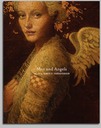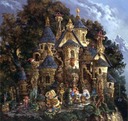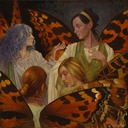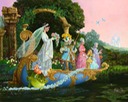Books about, or illustrated by James C. Christensen:
“A Journey of the Imagination”
From Flying Pigs to Goblin Princesses
James C. Christensen's art travels a magical journey
By Carma Wadley
OREM
— It is a magic world, the one that artist James C. Christensen invites
you to enter. Fishes appear in unexpected locations. Boats carry
amazing cargoes to unknown destinations. Pigs fly; hedgehogs come in
heliotrope; goblin princesses have pet beetles.
In
this place, there are no limits to imagination and creativity. Yet
there is a lightness of being and an uplifting sense of purpose to it
all. You want to linger. You want to savor. You want to spirit a tiny
part of it away with you.
You
can see and do all these things and more in the latest compilation of
Christensen's work, a gorgeous coffee-table book book called "Men and
Angels: The Art of James C. Christensen" (Greenwich Workshop Press,
$85). The book, which was co-written by Kate Horowitz, features more
than 300 full-color paintings and a selection of whimsical sketches from
Christensen's private sketchbooks as well as anecdotes, thoughts and
descriptions of each piece.
Christensen
is one of the most recognizable and critically acclaimed living artists
in the United States today, says Scott Usher, president of Greenwich
Workshop Press. "We are very excited about the release of 'Men and
Angels.' His work communicates on a level that is as personal as it is
universal. He has the unique ability to give life to characters that
appear to be both human and divine."
The book is also a fun journey of discovery for Christensen. "I'm not fond of any of my pieces when I finish them. I'm just glad they are going away," he says. "It's like composer Merrill Jenson told me once, 'It's because we know where all the bent nails are.' But give me a year or two, and I come back and think, 'That's nice.' I've forgotten where the personal problem areas are."
When
people ask him which is his favorite painting, "I always say, 'The next
one.' I always look forward to starting a new one. Then I get so
involved I can't see it objectively. So, having a book with my work from
the past 10, 20 years, that's pretty exciting, pretty fun."
Plus,
he says, every artist dreams of "leaving the legacy behind. The book is
a nice artifact for my children and grandchildren." (He and his wife,
Carole, have five children: two daughters are now artists in their own
right; a third daughter teaches art; the two sons "are not involved in
art but are very creative people.")
When
Christensen takes time to reflect on his career, he's as surprised as
anyone, he says. "I didn't grow up in an artistic family. They liked
art, but I didn't even know what art supplies were. I got my first
supplies at Disneyland. They had an art shop in Tomorrowland that I
absolutely loved."
Growing
up in Southern California, "I drew as long as I've been alive." But it
took him a while to get into art. "I did one painting on my own in high
school, and it was horrible. I didn't discover oils until I was a
sophomore at BYU."
When
he gives lectures to students, "they always want to know what my
five-year plan was. The truth is, I didn't engineer any of this. I
didn't know who Greenwich Workshop was when they called and asked if
they could make prints of my work."
But
there's a bit more involved. "That sounds like opportunities just fell
into my lap, and some did. But I don't believe in blind luck. I think
you have to work hard, do your best, constantly try to improve and give
every project 100 percent. It follows that the harder you work, the
luckier you get." Still, he says, "you do have to be in the right place
and have the right things to say."
For
Christensen, the things he says have always bordered on the magical.
He's commonly called a fantasy artist, but he sees himself, rather, as
an artist who paints the fantastic. "That's actually a 17th-century
term, like the work of Hieronymus Bosch. I paint things that are not
real. But fantasy often ventures into the dark and scary stuff. I made a
decision long ago that I would not go to dark places. There's a lot of
negativity in the world. I try not to be part of it."
His
paintings are filled with symbolism. "There are many layers of meaning
in my work, and I love to play with themes and metaphors."
If
our lives are like rivers, he says, then boats are a good place for
things to happen. He also often uses fish. If you are fully dressed and a
fish is there, "it means you are somewhere else, a magical place. I
like to juxtapose things that you might not think would go together. I
get a kick out of putting in a lot of symbols and letting people find
out what they are."
He
wants his paintings to be "a point of departure. I don't demand that
the viewer finds out what I'm trying to say. If they have different
ideas, I say 'hooray.' Sometimes I like theirs better; sometimes I steal
those."
He
does want people to use their imaginations. "We all have that ability
to think creatively, but I don't think we use it enough."
He
also tries to "connect with common themes, the issues that people have
to deal with — the burdens of a responsible man." Ideas, he says, are
all around us, all a part of life. "I try to explore them in a unique
way. Most times it's a fun way, sometimes it's a touching way. But this
is stuff we all go through."
If
his paintings often have a spiritual side, that, too, is natural.
"Every authentic artist paints who he is. My religion, my spiritual
belief system permeate my life and my artwork."
There
are some artists who "feel that if you don't put great angst into your
paintings, you are not serving art. I don't buy that. My contribution is
to try to encourage people to be happy, to enjoy life, to be positive."
He
knows a man who hangs a Christensen painting in his bathroom. "He told
me that every time he gets out of the shower, he sees it and it makes
him laugh. I say good for him!"
Some
of Christensen's artwork hangs in his own Orem home. "Carole gets to
pick one painting a year to keep. That was her deal way back when I was
just starting to get successful. I've also saved a couple that
particularly inspire me, and things that don't sell have a way of
dribbling back."
Christensen
taught at Brigham Young University for 20 years but has since "quit my
day job." Over the course of his career, he has been accorded numerous
honors and awards. He was recently designated as a Utah Art Treasure,
one of Utah's Top 100 Artists by the Springville Museum of Art and
received the Governor's Award for Art from the Utah Arts Council.
He
has won all the professional art honors the World Science Fiction
Convention gives out and has received multiple Chesley Awards from the
Association of Science Fiction and Fantasy Artists.
"Men
and Angels" is the latest of several books he has produced, including
"A Journey of the Imagination: The Art of James Christensen," "Voyage of
the Basset," "Rhymes & Reasons," "Parables" (written by Robert
Millet), as well as a series of interactive journals — all filled with
art that Greenwich Workshop notes is "born from his keen observation of
humanity and his endless supply of imagination."
Christensen
just "feels fortunate I get to work at a thing I love to do. The more I
discover about the world, from biology to art history, the more
enthralled I am with the magic that is human existence."
All in the family: James C. Christensen joins forces with 2 daughters for art show
Like father, like daughters? Well, yes and no.
By Carma Wadley
Cassandra
Christensen Barney and Emily Christensen McPhie may have inherited some
of their father's (fantasy artist James C. Christensen) art genes, but
they also have developed different approaches and styles that give them
their own voices.
Which
makes it especially delightful, they say, on the rare times when the
get to "sing in harmony," as it were — when they get to have a joint
exhibition of their artwork.
One
of those occasions is an upcoming show at Art Access Gallery. The show
opens Sept. 18 and runs through Oct. 7. An opening reception will be
part of the September Gallery Stroll.
Another thing that makes this show so delightful, the artists say, is the theme: "Hortus Conclusus, or The Enclosed Garden."
They
were sitting around one day, talking about ideas, explains Christensen.
"I had done a 'Tree of Life' that was in an enclosed garden, and our
discussion took off from there. We found the Latin term, and we realized
there was a lot of symbolism, a lot of metaphors in the idea of an
enclosed garden."
The
traditional design of a walled garden, split into quarters separated by
paths, dates back to the earliest gardens of Persia, he says. "The
'hortus conclusus' of High Medieval Europe was more typically enclosed
by hedges or fencing, or the arcades of a cloister."
But
the idea of enclosure was to create a protected and nurtured space,
"where ideas and people, like plants and flowers, can flourish. The idea
of a controlled safe place can represent the family, the community or
even the space in one's own mind."
For
Barney, the idea "got me thinking about what I want in my garden. It is
an intimate space, where you can create your own paradise." In doing
research for the show, she says, "I was delighted to find that the word
paradise is, by definition, a walled garden. It is a place to learn and
grow and create beauty. It's a safe place where there is celebration.
But it also needs to be tended, because behind its walls is also a place
to be vulnerable. There can be hummingbirds, but there can also be
demons. This has been one of my favorite themes to work on."
As
a mother of young children, McPhie's thoughts "immediately jumped to my
kids." Her marionette-like images for the show "are a comment on
parenthood, on how many decisions I make for them each day. And how do I
know when it's time to cut the strings? When is it time for them to go
outside the wall? There are so many emotions that go with those
decisions."
And
that, Christensen says, is really the fun part of working with his
daughters — "the ideas bouncing back and forth, the what-iffing, the
planning. I love these collaborations."
But
it's not like they ever exactly planned on being a family of artists.
"When we were growing up, Dad didn't push us to do art at all," Barney
says. "I didn't ever think that I would be an artist." In fact, she was
going to major in physical therapy — until she got to the first day of
classes. "I realized that I didn't want any of those classes; I wanted
to take art classes instead. I finally told my dad about halfway through
the semester."
That
was when she was attending what was then Ricks College (now BYU-Idaho).
"We took a physical therapist up and brought an artist daughter home,"
Christensen jokes.
But
he thinks that "part of the reason why Cassie and Emily are artists is
because they were not forced into it. I thought that I was the anomaly,
and they would grow up to be real people. But I always had the art
supplies around. If they wanted to color, they had 120 colored pencils
to choose from and a hundred colored markers."
He
also knew, however, that they would have to develop their own passion
for art. "My philosophy is that art is passion-motivated. Without
passion, it's just too hard. Passion leads to the desire to spend the
hours that are necessary. Passion leads to the work ethic. Passion means
you are willing to go under 'studio arrest' for periods of time."
And
that, says Barney, "is the thing that rubbed off on us. Dad had that
passion. We had his example of loving what he was doing. And he worked
hard at it. He would teach all day, and then come home and have supper
and do the family stuff, and then he would go to his studio and paint."
Christensen
is equally proud of his two non-artist sons. His middle daughter,
Sarianne, "works with me in the studio, hand-tinting art, and is head of
the art program at Pleasant Grove High School. She also does ceramics.
But she loves working with the kids."
But
it also has been satisfying to see his oldest and youngest daughter —
they are separated by 10 years — come into their own as artists.
For
the first few years, when they did something together, "it was, here's
James Christensen and, oh, by the way, he has daughters," he says. "But
the last year or two, it's getting to where they attract more attention
that I do. Cassie and I did a signing in Boise, and she had huge lines
at her table. The guy in charge asked me if I'd like him to slip people a
dollar to come see me. They don't need me anymore," he jokes.
Part of it, he says, "is because they blog. They blog worldwide" — Barney at churningsandburnings.blogspot.com; McPhie at tendernessandtoil.blogspot.com — "and now it's like they have best friends all over the world. They
have a tremendous following. They put their lives out there. They talk
about canning peaches. It's a way to connect with people that also helps
people connect with their art."
Barney
and her father get to interact frequently because they practically live
across the street from each other. Christensen will come and look at
one of Barney's paintings for the show that she is struggling with. "You
don't need to change it," he will tell her, "you just need to change
the way you look at it. You're going with the medieval fear-of-void
concept. Just pick a light source and add some shadows." Then, he adds,
"Tomorrow, she'll come over and fix my painting."
For
McPhie, who lives in Arizona, the constant interaction is a bit harder.
"But I get to come spend a month each summer," she said in a telephone
chat. "I get to paint in my dad's studio. I get to go shopping with them
for art supplies. That's the most fun thing — to stand in front of a
wall of colors and say, 'Have you tried this one?' or 'You've got to see
what this one does.' Of course, it was more fun when Dad paid for them
all."
It
was only when she got married and began to deal with in-laws, McPhie
jokes, "that I realized how odd my family was. Do you know there are
people who go to Europe and only go to one museum? I always thought
museums were the only things in Europe."
But
growing up, "I had a lot of influence, a lot of appreciation. I had
classmates who had parents who didn't see the value of art. I never had
to worry about that. And I kind of fell into it naturally. I also had
Cassie to look to; I learned a lot from her experience as an artist and
as a mother."
And
while there never has been any rivalry, says Barney, with a grin, "We
have learned that if you have a good idea, it's better not to tell
anyone about it, or they'll grab it. We do overlap a lot. Sometimes, we
simultaneously paint a unicorn tapestry. It's so bizarre."
But
even then, they do it in their own way. "Cassie paints something, and I
come over and it means something different to me," says Christensen.
And that, he says, is the pure joy and extreme value of art. "It can
have a lot of meanings. It's open-ended. It has the potential for people
to find their own meanings in it."
And that's exactly, he says, what the song of "Hortus Conclusus, or The Enclosed Garden" is all about.
Notes from a Lecture by James C. Christensen, March 5, 2010
On Friday, March 5, 2010, I attended a lecture by James C. Christensen at the Bridge Academy of Art in Provo, Utah. A truly fascinating experience. Below I’ve included some notes I took from his lecture:
• Influences:
Northern Renaissance
quirky perspective
attention to detail
Bosch
Brueghel
Durer
19th Century Romantics / Pre-Raphaelites
Leighton
Waterhouse
Dore
• Paints “slower than the drift of continents.”
• ”The harder you work, the luckier you’ll get.”
• Likes the work of Andrej Dugin and Olga Dugina.
• According to BYU professor Martha Peacock, “He (JCC) was born in the wrong century.”
• William Whitaker, a fellow professor at BYU, taught him how to paint in oils.
• Has a hard time working for money -- has to love what he’s doing; needs to be excited about it.
• Put in the time. Get good. 10,000 hours (Malcolm Gladwell’s “Outliers”) of practicing your craft is what it will take to get good.
• Worked on the murals for the Nauvoo Temple.
• Uses small sable hair brushes for his work in oil.
• Contributed to the book, “Star Wars: Visions.” He painted a Cantina scene from Mos Eisley on Tattoine.
• Making money on PRINTS (Greenwich Workshop) and the originals allows him to justify to amount of time that he puts into a painting.
• Has 57 volumes of sketchbooks, works almost exclusively in ink, and relies on them for ideas, working out compostions, observational sketching, etc.




































